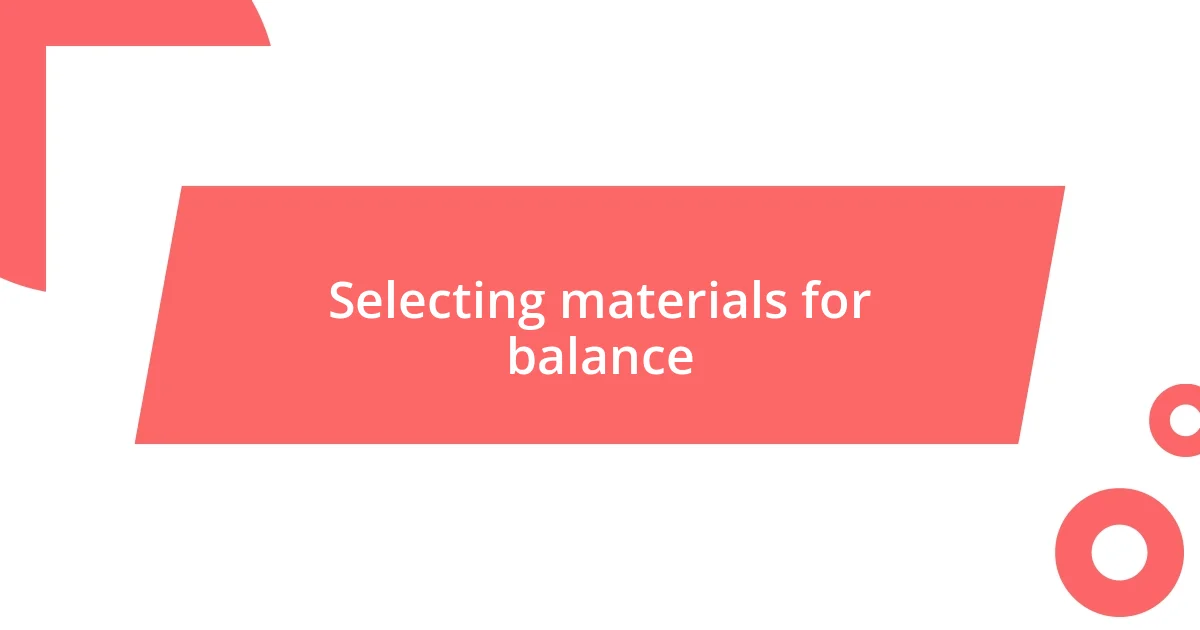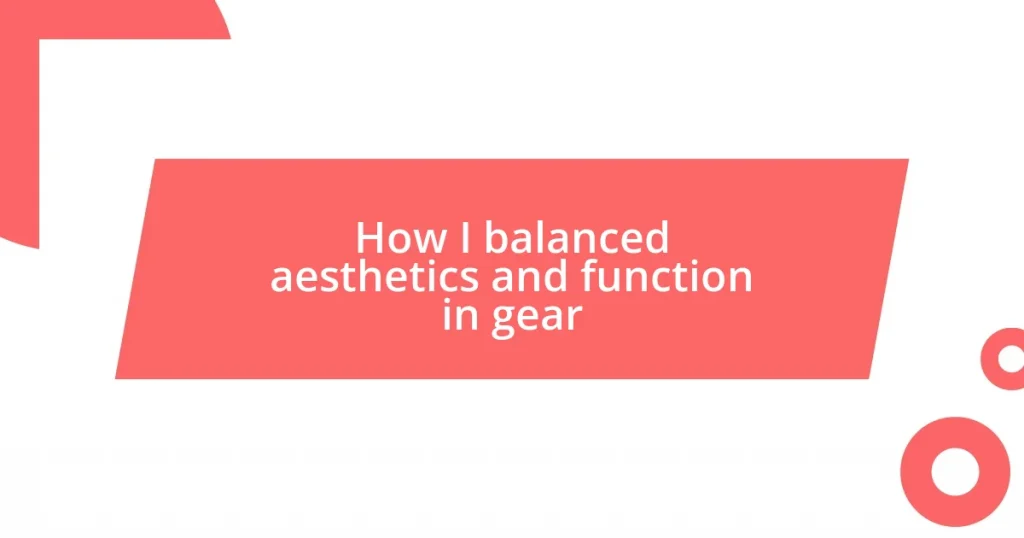Key takeaways:
- Aesthetics should not overshadow functionality; balance both to enhance outdoor experiences and ensure gear meets practical needs.
- Consider key functional requirements like durability, weight, capacity, and ease of use when selecting gear to improve performance and comfort.
- Designing gear for versatility and appeal fosters stronger connections with equipment, as thoughtful design enhances both usability and the overall experience.

Understanding aesthetics in gear
When I first started choosing gear, I was drawn to the sleek designs and vibrant colors, almost forgetting the practicality behind them. Have you ever experienced that moment when you realize a piece of equipment looks fantastic but just doesn’t hold up in the field? It’s like finding a beautiful book with a spine that crumbles under pressure—looks appealing, but ultimately falls short.
I remember buying a backpack that was not only visually stunning but also fit perfectly with my style. However, when I took it on a weekend hike, I quickly discovered that the straps were uncomfortable and the pockets too small. In today’s world, aesthetics often drive our decisions, but understanding how those choices affect functionality can significantly impact performance and comfort.
We often see gear that clings to trends rather than practicality, leading me to wonder: is a piece of equipment truly worth it if it sacrifices usability? A well-designed product seamlessly combines form and function, making every outing more enjoyable. Striking this balance can enhance not just our experience but also our appreciation for the gear itself.

Recognizing functional requirements
Recognizing functional requirements starts with understanding the specific tasks you need your gear to perform. In my experience, it’s easy to be distracted by aesthetic appeal, but the true value lies in how well a product meets your needs. For instance, when I upgraded my tent, I focused on weight, durability, and ease of setup, rather than just the latest design features.
Here are some key functional requirements I always consider:
- Durability: Will it withstand harsh weather conditions?
- Weight: Is it lightweight enough for comfortable transport?
- Capacity: Does it have enough space for all my gear?
- Ease of Use: How quickly can I set it up or access my belongings?
- Compatibility: Does it work well with my other equipment?
I remember the first time I hiked with a new stove that looked sleek and modern. I was excited, but, unfortunately, it took longer to ignite than I anticipated. That delay led to cold meals on a chilly morning, which was a disappointing experience. This is a perfect example of how overlooking functional requirements in favor of looks can impact not just convenience, but also enjoyment in the great outdoors.

Merging style with usability
Finding a harmonious balance between style and usability in gear can be quite the journey. I recall purchasing a pair of hiking boots that boasted a trendy design, complete with eye-catching colors and a modern silhouette. At first glance, they felt like a perfect match for my outdoor wardrobe. However, it took only a few trails to reveal that the arch support was minimal and the grip left much to be desired. The lesson? Aesthetics may turn heads, but comfort and performance must rule the day if you want to truly enjoy your adventures.
Matching style with usability often means making calculated compromises. For example, I once invested in a stylish water bottle, convinced that its design would inspire me to hydrate more. It was indeed beautiful and looked great on my desk, but I soon learned that the lid was a challenge every time I wanted a drink on the trail—leaks, spills, and frustration ensued. This experience taught me that the gear I choose should not only reflect my taste but also fit seamlessly into my routine and activities.
It’s a space where personal reflection becomes invaluable. When evaluating new gear, I often ask myself if I can see it being used in various scenarios while still looking great. Do I need something that stands out, or something that performs exceptionally under pressure? My favorite jacket is a perfect example: it has a clean design but is packed with functional features, like waterproofing and multiple pockets. This kind of gear makes me feel both stylish and prepared, striking that harmonious balance I strive for.
| Aspect | Description |
|---|---|
| Aesthetics | Visual appeal that draws interest |
| Functionality | Practical features that enhance usability |
| Durability | Ability to withstand wear and tear |
| Comfort | Ease of use and pleasant feel |

Selecting materials for balance
Selecting the right materials for gear isn’t just a technical choice; it’s a deeply personal one. I still recall the time I chose a backpack made from a high-denier nylon. It looked sleek and modern, but what really sold me on it was its water-resistant properties. When I unexpectedly found myself caught in a downpour, I realized that even the most beautiful gear loses value if it can’t withstand the elements. It was a moment of relief; I learned that investing in quality materials not only protects your gear but also your adventure, allowing you to focus on what truly matters.
As I navigated through the countless options available, the concept of breathability kept coming to mind. I once bought a lightweight shell jacket that was stunningly designed but ended up being too stifling on a warmer hike. I pondered, “What good is looking good if I can’t move freely?” The lesson was clear: the right fabric can enhance your experience significantly. Now, whenever I shop for clothing, I balance that ‘wow’ factor with practical attributes like moisture-wicking and ventilation to ensure I stay comfortable.
Sometimes it’s the little details that amplify your experience. For instance, I chose a camping chair made from a blend of aluminum and breathable mesh fabric. Not only did it look stylish, but it was incredibly easy to transport and set up. I felt a sense of satisfaction every time I pulled it out for a sunset view with friends. When materials are selected thoughtfully, they become more than just components; they enhance the joy of being outdoors and create cherished memories. How do you want your gear to feel when you’re using it?

Designing for versatility and appeal
Designing gear that serves multiple purposes while looking appealing can be an exhilarating challenge. I remember when I designed a multi-functional belt that not only held my essentials but also had a built-in bottle opener—a fun touch that sparked conversation during outings. It surprised me how something so small not only added versatility but became a favored topic among friends. Could a simple design element help build camaraderie on an adventure? In my experience, yes!
Staying true to aesthetics while ensuring functionality means keeping practicality at the forefront. I once collaborated on a project involving a stylish yet practical travel bag. The sleek exterior hid ample pockets, ideal for organizing travel essentials. Frankly, I was thrilled when others noticed it not just for its look but for its utility too. It got me thinking: how often do we choose form over function? By prioritizing both elements, we not only enhance our enjoyment but also foster a deeper connection with our gear.
I’ve found that the true essence of designing for versatility lies in anticipating practical needs without compromising visual appeal. A perfect example is when I worked on a pair of running tights that featured reflective accents for night runs. I loved how they looked sleek and sporty, but they also made me feel safer during early morning jogs. Isn’t it rewarding when you can create something that looks great while also enhancing safety and comfort? By marrying these attributes, you cultivate confidence in your gear, allowing you to fully immerse yourself in the experience.

Practical examples of gear design
When I think about practical gear design, one memorable experience comes to mind: my search for the perfect hiking boots. I stumbled upon a pair that combined rugged durability with a sleek, modern aesthetic. The best part? They were lightweight and featured an ergonomic design that hugged my foot comfortably. I distinctly remember the first hike I took in them, feeling the stability and control as I navigated rocky trails. Isn’t it fascinating how the right design can elevate your entire outdoor experience?
Another striking example of practical design was a robust water bottle I invested in. At first glance, it was visually striking with its vibrant colors and sleek silhouette. However, what truly impressed me was its functionality—it had an innovative lid that doubled as a drinking cup and a built-in carry strap. The reflection of my commitment to sustainability came full circle when I realized I was not only enjoying a beautiful accessory but also reducing my reliance on single-use plastics. Have you ever felt that connection between aesthetics and responsibility?
Lastly, I can’t forget the time I came across an elegant, compact first aid kit. It was cleverly disguised as a stylish pouch and fit right into my backpack without taking up space. This dual-purpose design saved me on a camping trip when my friend scraped her knee. The relief I felt from being prepared, combined with the chic look of the kit, made me realize how thoughtful design can blend seamlessly into our adventures. Isn’t it empowering when our gear reflects both our style and our readiness for anything?

Tips for evaluating gear choices
When evaluating gear choices, I always start by asking myself how well a piece aligns with my specific needs. I remember the time I chose a camera backpack; it was crucial that it not only looked good but also safeguarded my equipment during adventures. After doing my research, I found one that offered padded compartments and weather resistance—all while fitting my style. Isn’t it incredible how a well-chosen bag can make you feel like a true professional when capturing moments?
Another tip I’ve learned is to consider the versatility of gear. For instance, I once bought a pair of convertible hiking pants that zipped off to shorts. Initially, I wondered if I’d really use them, but they turned out to be a game-changer on a multi-day trek through changing climates. It felt rewarding to adapt my outfit on the fly, saving space in my pack without sacrificing comfort. How often have we overlooked the practical benefits of multi-functional gear?
Lastly, I pay close attention to the reviews and experiences of others. I vividly recall reading about a compact camping stove that not only boasted efficiency but also scored high marks for portability. It was a choice driven by the combined insights of the community and my own desire for reliable outdoor cooking. I felt a sense of reassurance knowing I wasn’t alone in my evaluation process. Have you ever felt more confident in your choices by leveraging the experiences of other adventurers? I certainly have, and it leads to smarter, more satisfying gear selections.















